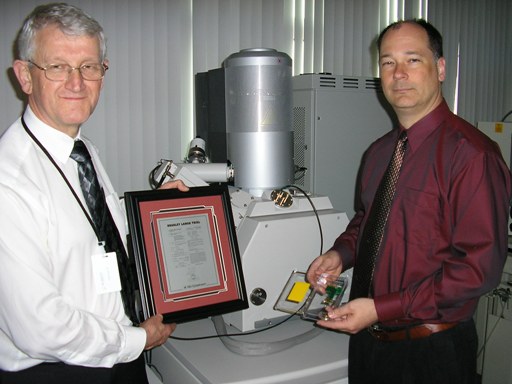Welcome
Welcome
Introduction
Introduction
CNSE Quick Facts
CNSE Quick Facts
Why CNSE?
Why CNSE?
Albany NanoTech Complex
Albany NanoTech Complex
CNSE virtual tour part 1
CNSE virtual tour part 1
CNSE virtual tour part 2
CNSE virtual tour part 2
Vision and Mission
Vision and Mission
History
History
Constellations
Constellations
UAlbany Senate
UAlbany Senate
Bylaws/Charters
Bylaws/Charters
Events Calendar
Events Calendar
Advising at CNSE
Advising at CNSE
Application and Admission
Application and Admission
Requirements
Requirements
Courses
Courses
Course Descriptions
Course Descriptions
Undergraduate MAP
Undergraduate MAP
Honors Program
Honors Program
General Education Program
General Education Program
Undergraduate Open House
Undergraduate Open House
Nano+MBA Courses
Nano+MBA Courses
MBA Track in Nanotechnology
MBA Track in Nanotechnology
Course I
Course I
Course II
Course II
Course III
Course III
Course IV
Course IV
Undergraduate Program
Undergraduate Program

Masters Programs
Masters Programs
Doctor of Philosophy Programs
Doctor of Philosophy Programs
Nano+MBA
Nano+MBA

Foundations of Nanotechnology
Foundations of Nanotechnology

Nanoscale Science Program
Nanoscale Science Program
Nanoscale Engineering Program
Nanoscale Engineering Program
CNSE Courses
CNSE Courses
Nanoscience
Nanoscience
Nanoengineering
Nanoengineering
Nanoeconomics
Nanoeconomics
Nanobioscience
Nanobioscience
CIMAV
CIMAV
2009 Summer Internship Recap
2009 Summer Internship Recap
2008 Summer Internship Recap
2008 Summer Internship Recap
2007 Summer Internship Recap
2007 Summer Internship Recap
2006 Summer Internship Recap
2006 Summer Internship Recap
Commencement Archive
Commencement Archive
Degree Programs
Degree Programs

Constellations
Constellations

Admissions
Admissions
CNSE Courses
CNSE Courses
Academic Partnerships
Academic Partnerships

2010 Internship Program
2010 Internship Program

Graduate Open House
Graduate Open House
Financial Support
Financial Support
Events Calendar
Events Calendar
About the Campus
About the Campus
Commencement
Commencement

Request Information
Request Information
Analytical & Characterization
Analytical & Characterization
Other Analytical
Other Analytical
Sample Preparation
Sample Preparation
EUV Lithography
EUV Lithography
Litho & Patterning
Litho & Patterning
Thin Film & Growth
Thin Film & Growth
Etch & Planarization
Etch & Planarization
Compound SC Processing
Compound SC Processing
Analytical & Characterization
Analytical & Characterization
Other Analytical
Other Analytical
Sample Preparation
Sample Preparation
Albany NanoTech Complex
Albany NanoTech Complex
CNSE Virtual Tour
CNSE Virtual Tour
Metrology Labs
Metrology Labs

Tools
Tools

200mm Wafer Fabrication
200mm Wafer Fabrication
300mm Wafer Fabrication
300mm Wafer Fabrication
Contractor Forms & Training
Contractor Forms & Training
Request Information
Request Information
Register for INDEX Review
Register for INDEX Review
CSR
CSR
NNICC
NNICC
CHIP
CHIP
CCIC
CCIC
IMPLSE
IMPLSE
INVENT
INVENT
NISE
NISE
NC3
NC3
International SEMATECH
International SEMATECH
Center for Nanoscale Lithography
Center for Nanoscale Lithography
Applied Materials R&D Center
Applied Materials R&D Center
TEL Technology Center, America R&D Center
TEL Technology Center, America R&D Center
IRETI
IRETI
NY CAIST
NY CAIST
CATN2
CATN2
CSEN
CSEN
E2TAC
E2TAC
Focus Center - New York
Focus Center - New York
INDEX
INDEX

Apprenticeships
Apprenticeships
CNSE-CTI
CNSE-CTI
Community Colleges
Community Colleges
High Schools
High Schools
CNSE's NanoHigh Program
CNSE's NanoHigh Program
Four-Year Colleges
Four-Year Colleges
Equipment Supplier Technicians
Equipment Supplier Technicians
Technical Seminars & Workshops
Technical Seminars & Workshops
Strategic Partners
Strategic Partners
Center of Excellence
Center of Excellence
Centers and Programs
Centers and Programs

Workforce Training
Workforce Training

Become a Partner
Become a Partner
Biomedical
Biomedical
Chemistry
Chemistry
Energy and Environment
Energy and Environment
Material Science
Material Science
Microsystems
Microsystems
Semiconductor
Semiconductor
View Nanotechnologies
View Nanotechnologies

Sponsored Research
Sponsored Research
Facilities Access
Facilities Access
Forms and Information
Forms and Information
Resources
Resources
Staff Contacts
Staff Contacts
Profile Archives
Profile Archives
Centers and Programs
Centers and Programs
CNSE Tech Management
CNSE Tech Management

Research Profiles
Research Profiles

Events Calendar
Events Calendar
Executive Staff
Executive Staff
Operational Staff
Operational Staff
Technical Staff
Technical Staff
Faculty
Faculty
Staff
Staff

Constellations
Constellations
Overview
Overview
Energy/Environment
Energy/Environment
Health Care
Health Care
Defense
Defense
Electronics
Electronics
Software/Media/Telcom
Software/Media/Telcom
Overview
Overview
Careers
Careers
Job Fair
Job Fair
Request Information
Request Information
Educational Outreach
Educational Outreach
Community Outreach
Community Outreach
Excelsior Scholars
Excelsior Scholars
NanoCareer Day
NanoCareer Day
Nano Games
Nano Games
NanoHigh Program
NanoHigh Program
CNSE Outreach Report
CNSE Outreach Report

K-12 Links
K-12 Links
iKnow Nano TV Segments
iKnow Nano TV Segments
Photo galleries
Photo galleries
Events Calendar
Events Calendar
Request Information
Request Information
CNSE Quick Facts
CNSE Quick Facts
Backgrounder
Backgrounder
Bios
Bios
Faculty experts
Faculty experts
Photos
Photos
CNSE virtual tour part 1
CNSE virtual tour part 1
CNSE virtual tour part 2
CNSE virtual tour part 2
Video files
Video files
Photo galleries
Photo galleries
Audio files
Audio files
"Inside CNSE" videos
"Inside CNSE" videos
Educational Outreach
Educational Outreach
Community Outreach
Community Outreach
NANOvember
NANOvember
CNSE Community Day
CNSE Community Day
NanoDays 2009
NanoDays 2009
In the News
In the News
News Releases
News Releases
Press Kit
Press Kit

Media Center
Media Center

Report from the NanoDesk
Report from the NanoDesk
NanoNow
NanoNow
CNSE Outreach Report
CNSE Outreach Report

Community Events
Community Events

Events Calendar
Events Calendar
Job Fair
Job Fair
Request Information
Request Information
Contact Information
Contact Information
Directions
Directions
Events at CNSE
Events at CNSE
Request Information
Request Information
Commencement Archive
Commencement Archive
Colloquia
Colloquia
Lectures
Lectures
Meetings
Meetings
Seminars
Seminars
Open House
Open House
Commencement
Commencement

Job Fair
Job Fair
Events at CNSE
Events at CNSE




